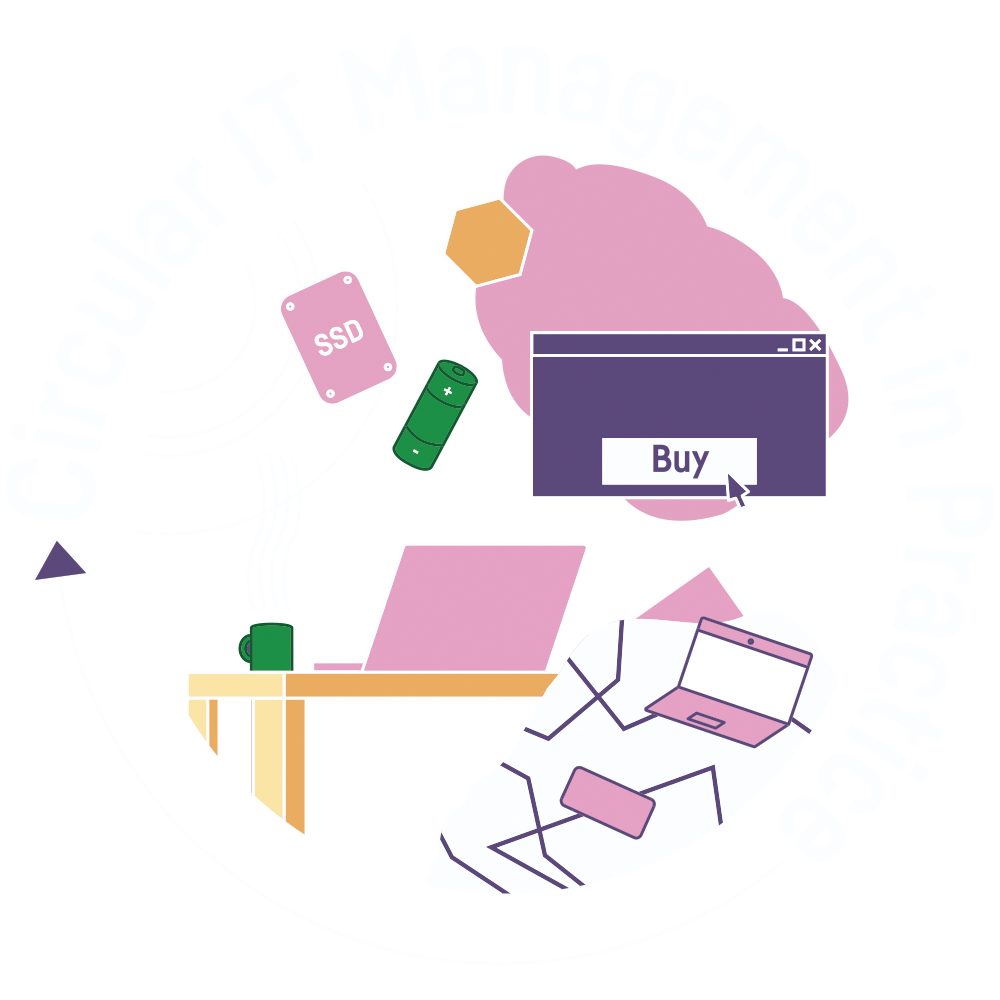For IT buyers, the circular economy means planning, buying and using electronics so they have a longer life and don’t become toxic e-waste. Our 2020 report Circular IT Management in Practice, is a deep dive into circularity – but what are the practical steps that you need to start with?
We’ve put together an easy-to-follow action plan with tips on buying and managing your electronics for the circular economy. In the circular economy, there’s a hierarchy of priorities – often referred to as “loops”:

A circular approach starts upfront – in procurement
The best time to start thinking about being more circular is upfront, in the procurement phase. This is when you can effectively communicate with suppliers about your plans for longer use (and reuse), develop waste prevention strategies, and even impact product design. Contact us for guidance on getting circularity into your IT procurement.
Let’s get started!
Priority 1: use your IT longer – extend first use, share, repair, redeploy
Many devices are discarded while they still have usable life in them. And since almost 80 percent of a computer’s lifetime emissions occur in the manufacturing phase – using products for longer reduces lifetime emissions and total cost of ownership.
Recommended actions
- Plan for longer use in your vendor contract terms. Consider warranties, service agreements and factor these into your total cost of ownership
- Signal to your suppliers, early and often, that longer use is your goal. Some purchasers are able to sign 5-year replacement cycles with vendors
- Use wisely
- Keep the device at between 20 to 80 percent of full battery charge
- Don’t overheat the device
- Use good quality chargers
- Repair/upgrade – replace or upgrade key components instead of the entire device
- Battery
- Memory
- HDD, SSD
- Ask brand owners for repair manuals. If they cannot provide enough information for repairs try Access open-source repair resources – eg iFixIt.com offers online repair manuals for a wide variety of devices
- Share!
- Explore options for device sharing, for example, could a device be used by multiple users?
- Used devices can often be redeployed in less data-intensive tasks or users – eg elementary school children
- Donate or sell surplus inventory to employees, students, reputable charities
Priority 2 and 3: reuse – refurbish/remanufactured – selling used inventory and buying non-new products
Demand for refurbished and remanufactured IT is growing. Partly due to an increased sustainability awareness, partly because IT products contain an embedded value that can give them a second life. Refurbished or remanufactured products often deliver like-new looks and performance.
Recommended actions
- Make refurbished or remanufactured products part of your IT management plan
- In procurement, specify a minimum percentage of refurbished/remanufactured hardware to be supplied (eg through contract performance criteria)
- Sell your used devices to a reputable refurbishing /remanufacturing partner
- If taking directly to a refurbisher/remanufacturer or a collection point – make sure they, or their providers, meet e-Stewards, R2 certification or equivalent
- Protect your data – ensure secure data removal from your devices before selling – either through manufacturer-provided software or by the refurbisher /remanufacturer
Priority 4: recycle – when longer use and reuse are not possible
Recycling is a less preferable, resource-intensive process where most materials lose value. Recycling must be carried out in a safe and responsible way, preventing illegal export and uncontrolled salvage with severe human health and environmental risks.
Recommended actions
- First, ask yourself – Have all options for longer use, reuse and refurbishment been considered?
- Find out if your IT supplier/brand offers a takeback program. If so, make sure to talk with them about longer use, so you are not locking yourself into a short replacement cycle
- Make sure that all take back, and recycling programs are WEEELabex, e-Stewards, R2, Cenelec or equivalent proven by an independent auditor
- At a minimum, all recycling facilities should hold governmental recycling and/or waste management permits
Time to buy new?
Until completely circular, zero-waste solutions are in place, buying new IT is still part of our reality. When it’s time to buy new equipment, make sure to specify TCO Certified in your policies and procurement processes. TCO Certified is free to use, just like an ecolabel, but with the additional benefit of independent verification on every model we certify – both at the product level and in the supply chain. So you can be sure you’re covering issues like environmental impact, climate, and ethical manufacturing conditions.

Dmytro Kapotia leads our support to purchasers in Europe and occasionally writes for the TCO Certified Blog. Dmytro is passionate about sustainability, cycling, and DJing.





